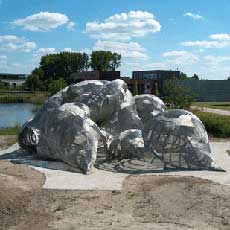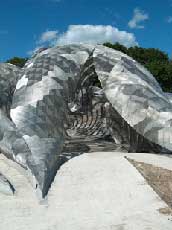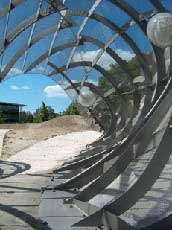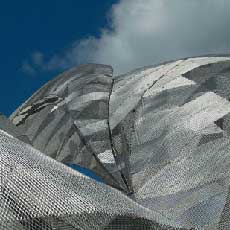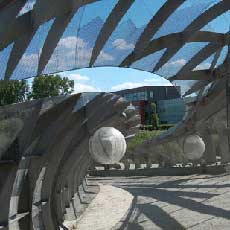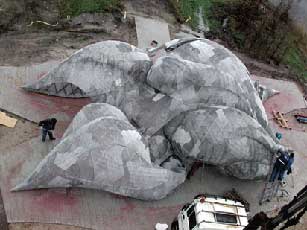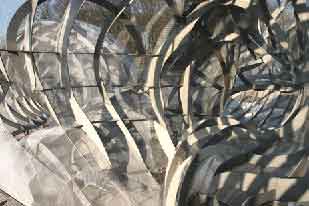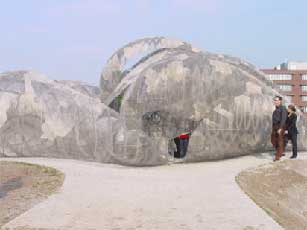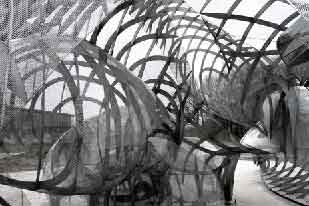
|
A
Son-O-House é um daqueles projetos artísticos típicos
dos quais devemos ser mais cuidadosos a observar, ao se utilizar de
muitos dos conhecimentos que foi aplicamos à projetos maiores
e mais avançados. A Son-O-House é o que nós chamamos
da casa de onde os sons vivem, não sendo uma casa real, mas
uma estrutura que permite viver e através de movimentos corporais
que acompanham o hábito e os movimentos do habitante. Na Son-O-House
um trabalho sonoro gera continuamente novos padrões sonoros
ativados pelos sensores que captam os movimentos reais dos visitantes.
Ao longo da estrada entre Son en Breugel e Eindhoven situado num grande parque industrial especialmente reservado para companhias do IT e indústrias de novas-mídias. O papel da obra de arte é aproximar a identidade da área, não somente como uma indicação tecnológica mas também como um espaço social onde se possa organizar reuniões informais, relaxar durante os horários de almoço ou simplesmente apreciar sua beleza. A estrutura é uma instalação arquitetônica e sonora que permita que os povos ouçam não apenas o som em uma estrutura musical, mas permitem participarem também da composição do som. É um instrumento, contagem e estúdio ao mesmo tempo. A estrutura é derivada de ações entre paisagens locais que se condensam em uma casa: uma tela de movimentos corporais, seja em grande escala, em um corredor ou em um quarto, ou em movimentos da escala menor em torno de um dissipador ou de uma gaveta. Este cuidadoso jogo coreográfico de movimentos de corpos, temos os membros e as mãos como faixas de papel cortadas (uma área não cortada corresponde com o movimento corporal, um primeiro corte completamente ao meio corresponde com um membro, e uns cortes mais finos correspondem com os movimentos das mãos e dos pés). Nós grampeamos as faixas de papel junto ao ponto onde se têm o potencial mais conectivo e em conseqüência disso uma curvatura emerge. O resultado é um arabesque de complexas linhas que demonstra uma leitura dos movimentos em várias escalas corporais e uma estrutura material desde que as curvas de papel estão eretas na cooperação com o usuário. Nós somente temos que varrer estas linhas lateralmente para casar a estrutura aberta das linhas com a superfície. Isto resulta outra vez em uma estrutura porosa tridimensional que é muito similar à estrutura que é obtida, ondular assim como fios de cabelo. Nós programamos este modelo análogo-computacial do papel e remodelamo-os na estrutura final das curvas que se inclinam ou se entrelaçam. Na "casa" que não é verdadeiramente uma casa nós posicionamos 23 sensores em pontos estratégicos para influenciar indiretamente a música. Este sistema sonoro, composto e programado pelo artista Edwin van der Heide, é baseado em "moirÈ efects" da interferência de freqüências relacionadas. Um visitante não influencia o som diretamente, mas através de um banco de dados presente na casa, ao longo do tempo a "casa" produz novas relações e conseqüentemente novas interações. [www.noxarch.com] |
|
The
Son-O-House is one of a typical art projects which allow us to proceed
more carefully and slowly (over a period of three to four years) while
generating a lot of knowledge that we apply to larger and speedier
projects. Son-O-House is what we call åa house where sounds
livep, not being a årealp house, but a structure that refers
to living and the bodily movements that accompany habit and habitation.
In the Son-O-House a sound work is continuously generating new sound
patterns activated by sensors picking up actual movements of visitors.
Along the highway between Son en Breugel and Eindhoven situates a large industrial park with a special quarter reserved for companies from the IT and new-media industry. The artworks role is for strengthening the identity of the area, not only as a technological statement but also as a social space where people can organize informal meetings, relax during lunch hours or just enjoy its beauty. The structure is both an architectural and a sound installation that allows people to not just hear sound in a musical structure, but also to participate in the composition of the sound. It is an instrument, score and studio at the same time. The structure is derived from typical action-landscapes that develop in a house: a fabric of larger scale bodily movements in a corridor or room, together with smaller scale movements around a sink or a drawer. This carefully choreographed set of movements of bodies, limbs and hands are inscribed on paper bands as cuts (an uncut area corresponds with the bodily movement, a first cut through the middle corresponds with limbs, and finer cuts correspond with movements of the hands and feet). We staple the pre-informed paper bands together at the point where they have the most connective potential and as a result curvature emerges. The outcome is an arabesque of complex intertwining lines (white paper model) that is both a reading of movements on various bodily scales and a material structure since the paper curves stand upright in cooperation with each other. We only have to sweep these lines sideways to marry the open structure of lines with the closed surface of the ground. This results again in a three-dimensional porous structure (purple paper model) which is very similar to the structure that is obtained by the combing, curling and parting of hair. We digitize this paper analog-computing model and remodel it into the final structure of interlacing vaults which sometimes lean on each other or sometimes cut into each other. In the house-that-is-not-a-house we position 23 sensors at strategic spots to indirectly influence the music. This system of sounds, composed and programmed by sound artist Edwin van der Heide, is based on moirÈ effects of interference of closely related frequencies. As a visitor one does not influence the sound directly, which is so often the case with interactive art. One influences the real-time composition itself that generates the sounds. The score is an evolutionary memoryscape that develops with the traced behavior of the actual bodies in the space. [www.noxarch.com] |

